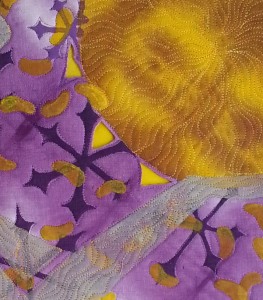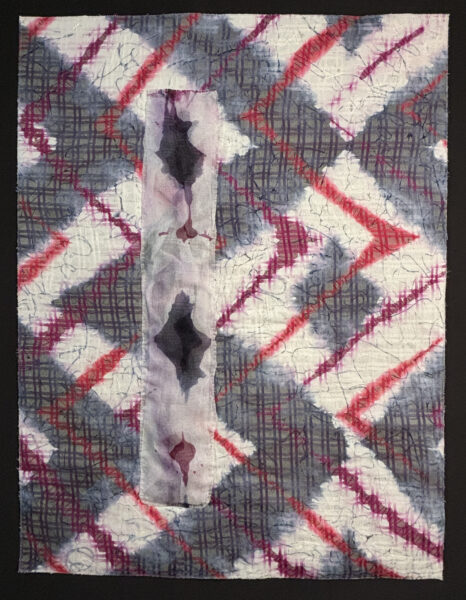
A ‘deconstructed American flag,’ this work’s title references Yeats’ poem, The Second Coming. It is layered hand-dyed silks, fused and hand-stitched. The Where Do We Go From Here? series explores way-finding in a chaotic world.
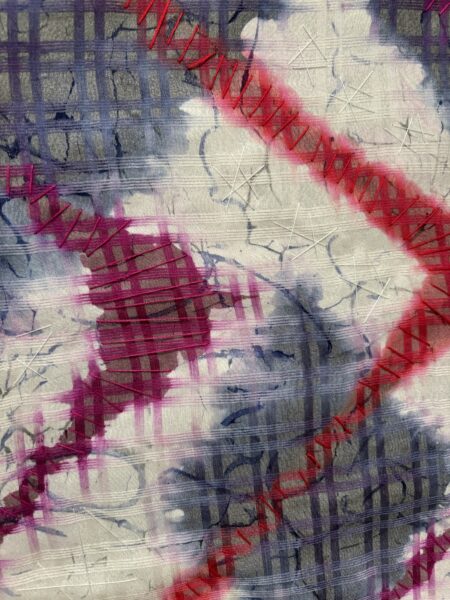
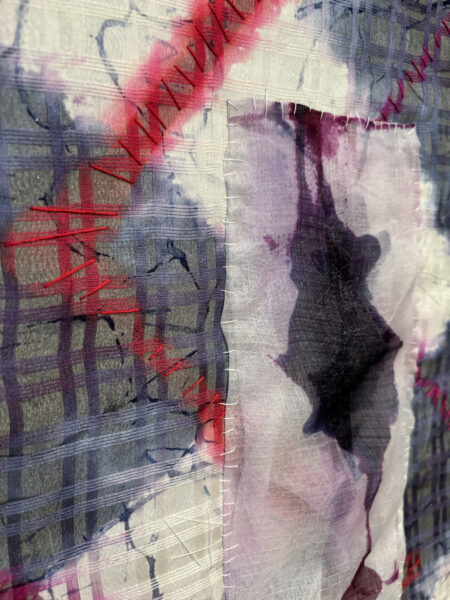
Political statements in fabric.


A ‘deconstructed American flag,’ this work’s title references Yeats’ poem, The Second Coming. It is layered hand-dyed silks, fused and hand-stitched. The Where Do We Go From Here? series explores way-finding in a chaotic world.


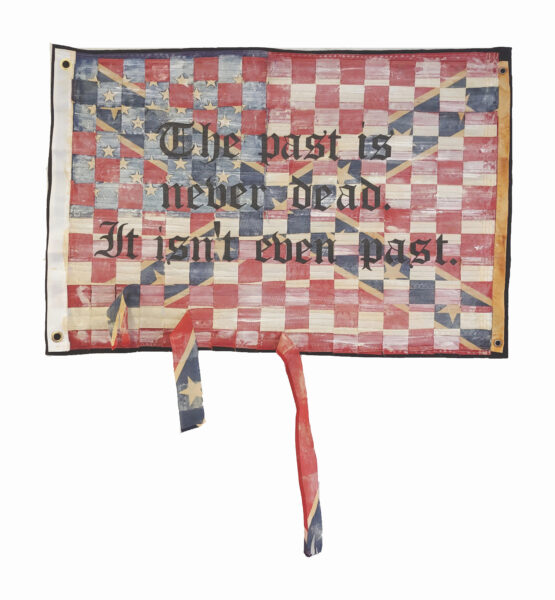
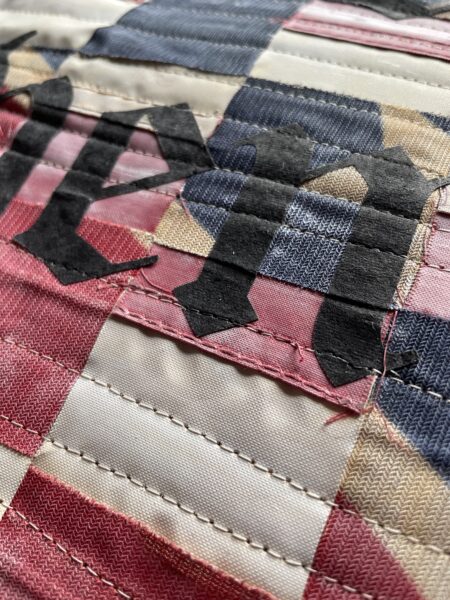
I am thrilled to announce that this work will be part of the Smithsonian’s We Are the Story traveling exhibition. Learn more about the exhibition, Curated by Carolyn Mazloomi, here.


I am ending 2023 with the first piece in a new series, “Where do we go from here?”. I feel I am at a crossroads (and our country is, too). I’m wrapping up a huge multi-year project (have you heard of it?)… supporting loved ones with serious medical issues… grieving my parents and the sense of mortality that comes with that loss.
No, I don’t have 2 actual boyfriends. The first class I took with Jane Dunnewold was about applying color, line, and shapes to plain fabric. She warned us that some of us would come to her with our ‘boyfriends’–fabrics we had created and loved so much that we wouldn’t want to change them. I have been hanging on to these boyfriends for years, wondering what in the heck to do with them. Here I have appliquéd a sheer silk organza boyfriend onto a Fuji silk broadcloth that was dyed using a Katano shibori method. Hand stitched with single strand embroidery thread (this was really tough on my hands and I won’t be able to handwork an overall design again any time soon).
I kinda like the new guy. What do you think?
You can see the work at Agua Caliente Park in Tucson. Show details below. I am looking forward to a productive and art-filled 2024 with some new friends and exciting challenges. What is on your calendar?
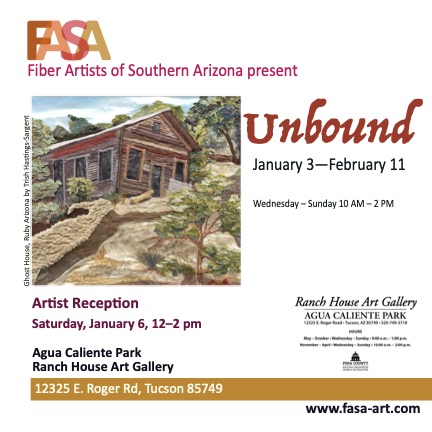
I created this in response to a call for art to the members of Art Cloth Network by the Kemerer Museum of Decorative Arts in Bethlehem, PA. The show’s theme is “Luxury and Industry.”
I was able to research the silk industry in America (yes, really!), the role of women and child laborers, and union organizing by the mighty Mother Jones. Online searches for images of ‘child labor textile industry’ revealed nearly identical photos, taken a hundred years apart in the US (then) and overseas (now).
That got me thinking….
As I made the piece, news organizations reported on the use of immigrant children who are applying for official status in the US in dangerous working conditions. And the loosening by states of child labor protection laws.
Everything old is new again.
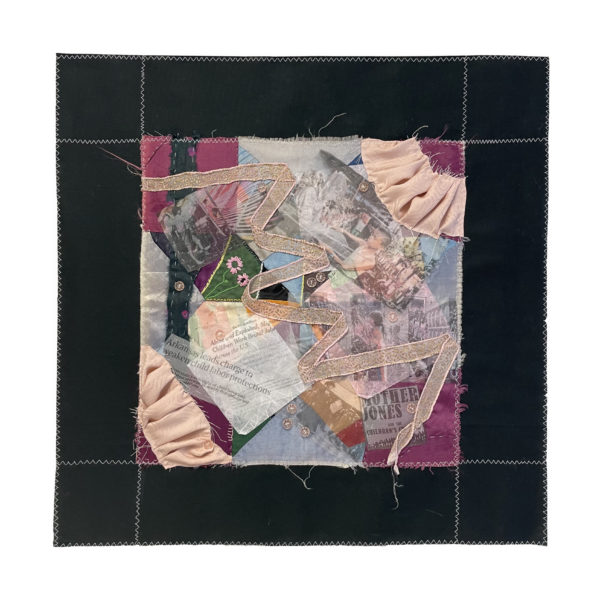
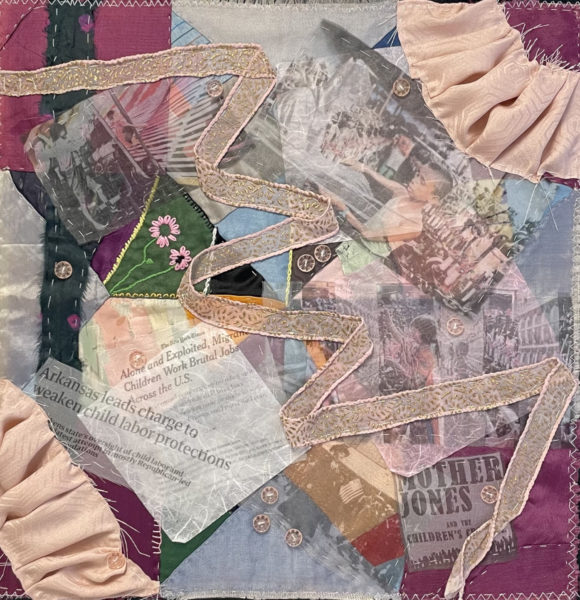
Materials: Vintage unfinished crazy quilt block, layered with vintage kimono scraps, hand-printed ribbon, collaged photographs printed on silk organza, antique glass buttons. Hand and machine stitch.
This 24 x 48” version of The Mourning Project: One Day features 63 pairs of handmade baby booties, one little elegy for each child lost before their first birthday every day in the US. It is a tiny portion of the 20,000 pairs we are collecting from makers all over the world to draw attention to the infant mortality rate in this country.
This version of the project will be at the Norfolk D’Art Center in Norfolk, VA for their Materials II exhibition, from October 10th, 2020-November 7th, 2020. Opening reception is Thursday, October 15 from 5:30-7:30 pm. The awards will be announced on Facebook Live, so stay tuned!
TMP makers–do you see your booties below? If not, check out the online installation by clicking here. Thank you to all who have contributed to save the lives of our most vulnerable citizens. Join us by submitting your booties today.
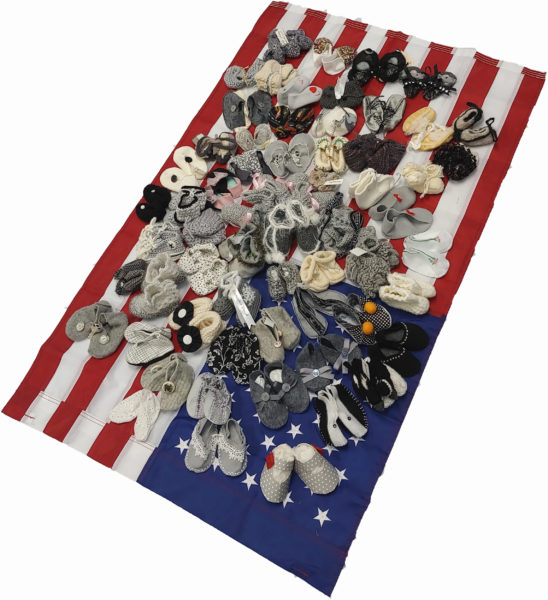
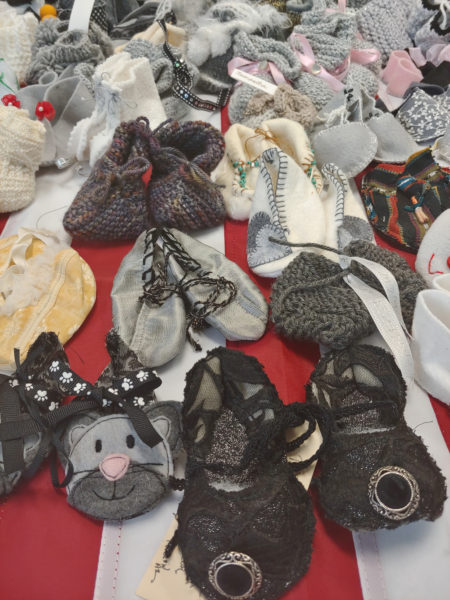
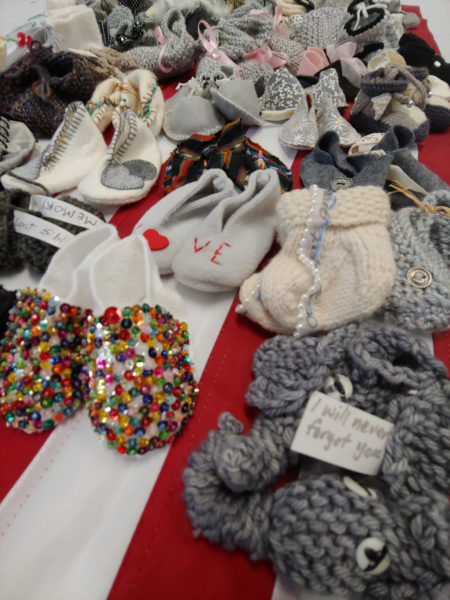

This piece was completed just in time for the call for submissions to the We Are the Story exhibition at the Textile Center in Minneapolis, MN. I was thrilled that Unravelling is part of the Racism: In the Face of Hate, We Resist portion of the show. The exhibit is curated by Dr. Carolyn Mazloomi and is getting a lot of buzz.
The quote is by William Faulkner, one of our greatest writers, and one of the first sons of the American South to feature relationships between black and white characters in his fiction. As flawed as Faulkner was on issues of race, his words very succinctly describe why we must work today to make amends for the systemic racism in our country today. For an ‘antiracist reading list,’ click here.
Materials: flags, woven and whitewashed, fusible web, hand-painted non-woven, felt, cotton backing, thread.

UnRavelling is a sister quilt to (White) Silence is Violence), which is also in the show. This piece was made in 2018 and is now in a private collection.

Another interpretation of the slings used by migrants crossing the border to carry water. This version incorporates found used clothing and a deconstructed American flag, layered with printed silk organza and hand stitching. Includes one carpet shoe found at the border. Printed text is from newspaper headlines about the Trump administration’s detention centers.

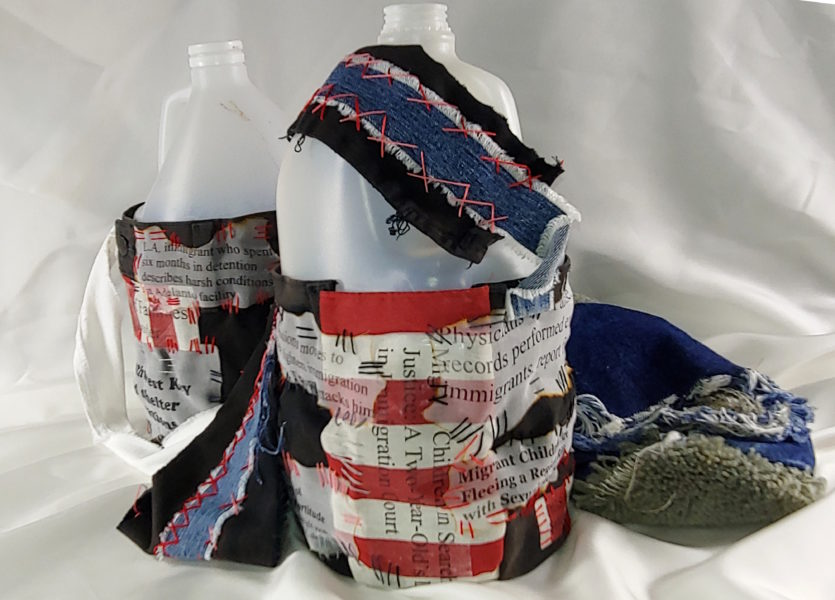
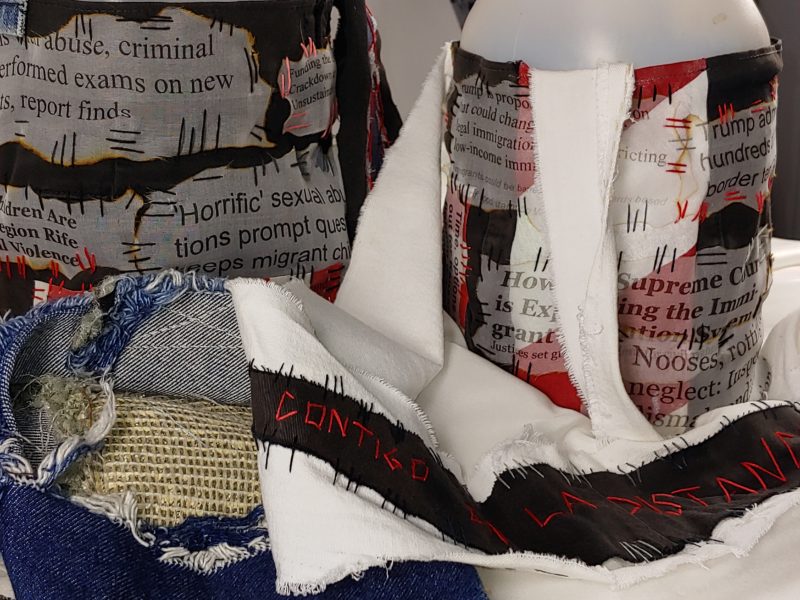
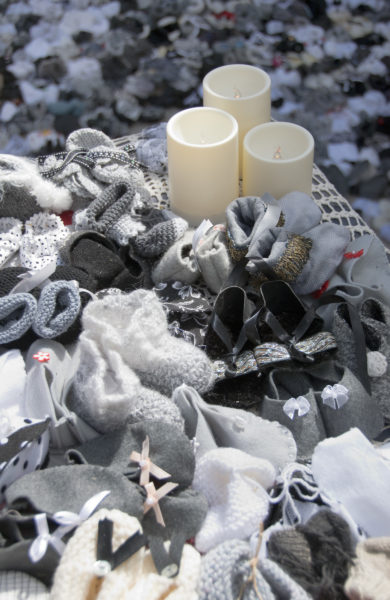
The Mourning Project is a huge community fiber art project to collect 20,000 handmade baby booties, one for each American infant who dies before her first birthday every year. The US has the worst infant mortality rate in the developed world. This project seeks to educate the makers and viewers about the issue, and start a discussion on how we can address this as a country.
The YWCA of Southern Arizona hosted the first installation of The Mourning Project, Little Elegies, April 2019 in Tucson. By this time makers contribute over 3,000 pairs of handmade baby shoes. These are some images of the first exhibition. Future installations will vary by venue as more makers donate booties.
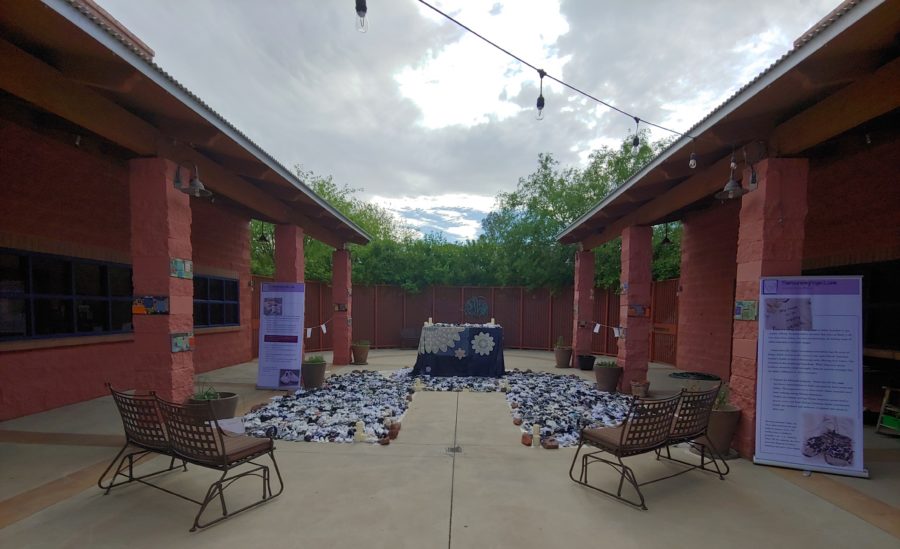
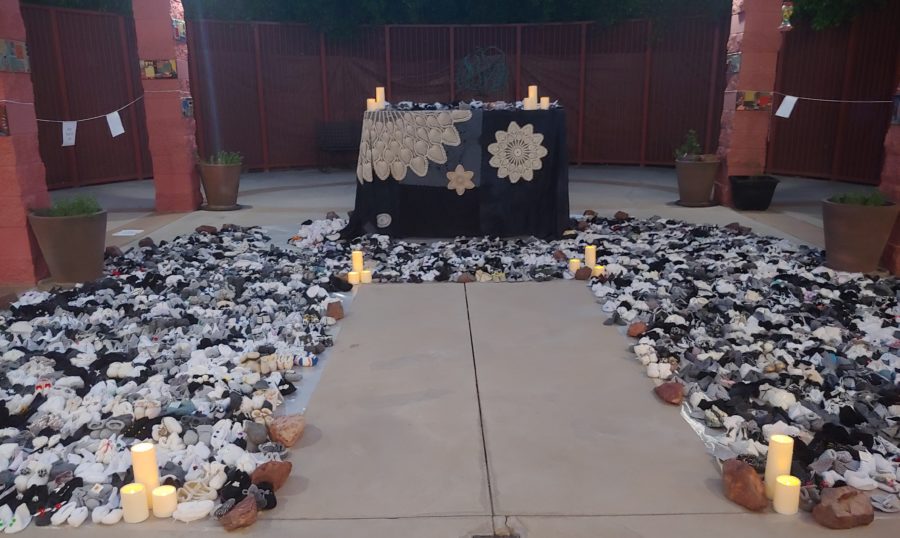
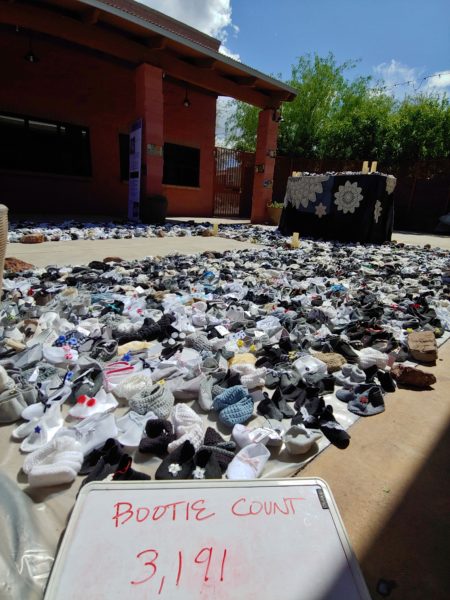


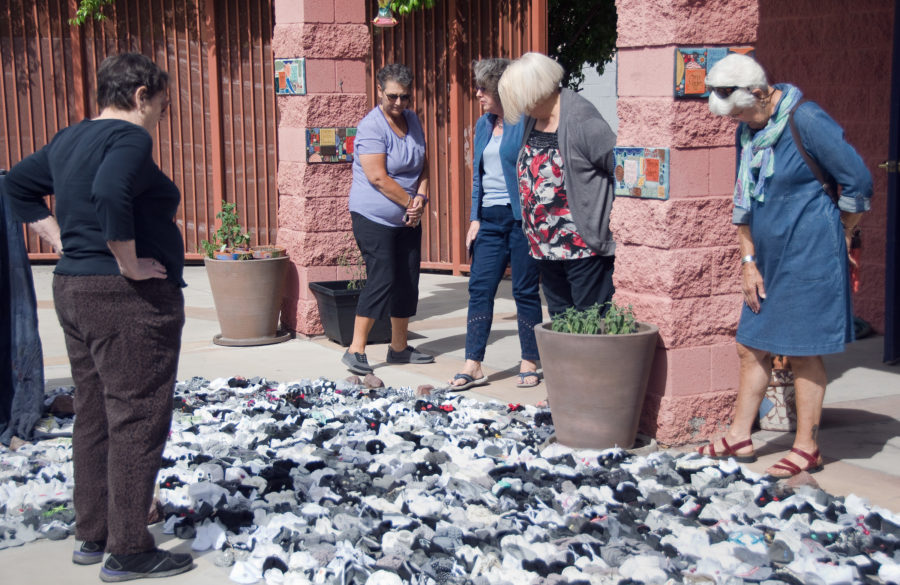
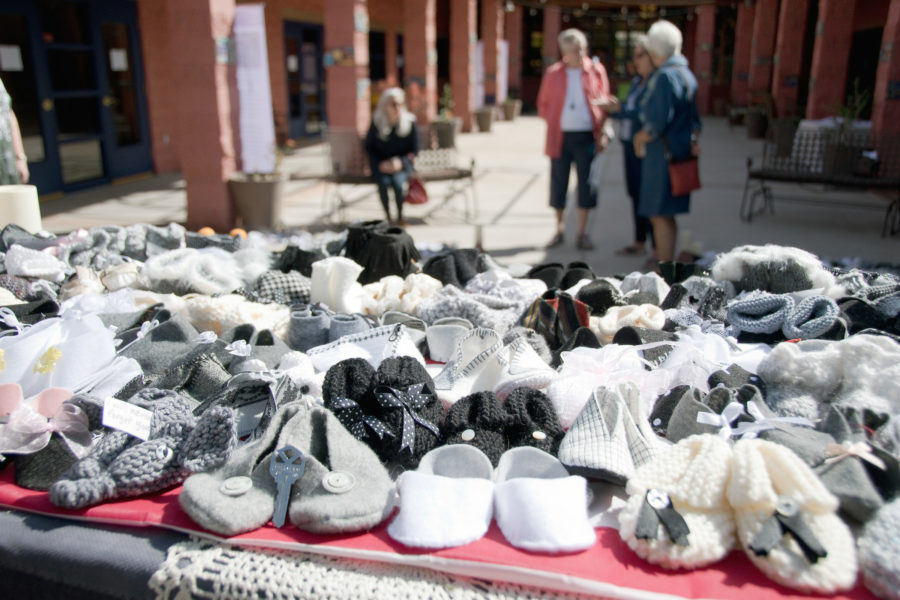
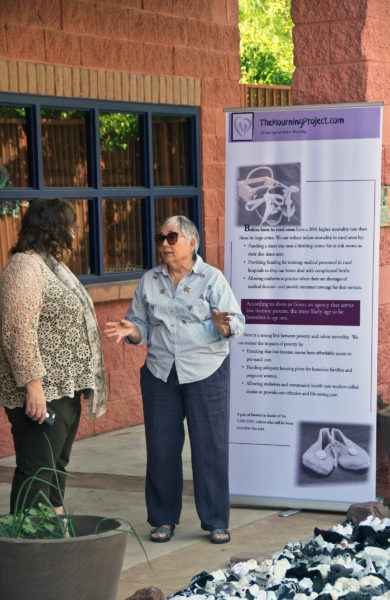

The Weight of Water by Mary Vaneecke, 20” x 20” by 12”
When I attended a photo shoot for The Migrant Quilt Project I was struck by the fabric slings for water bottles that Jody Ipsen brought from campsites along the border. Jody is the founder of the MQP. Crossers or their loved ones or immigrants rights groups make these slings hastily. They sometimes include encouraging messages like bueno suerte (good luck) or contigo en la distancia (with you on your journey). It hit me how these migrants had to carry enough water with them to survive their journey. They had to decide what to carry with them across the border, and what to leave behind on their way to a new life.
The items left at campsites or layups tell of a journey fraught with peril and loss. Jody allowed me to photocopy pages from a book for prayers to Santa Muerte, or Saint Death. Santa Muerte is important because she can protect crossers from violent death. Jody also shared copies from a small notebook filled with handwritten poetry or Verzos. (One of those poems is for Mother on Mother’s Day.) Ten dollars worth of pesos secreted into hand-stitched hems is another frequent find. Migrants often carry milagros or votives with them. Empty gallon jugs and carpet shoes, which mask footprints when worn over street shoes, are common in layup sites along the border.
My version of these slings include headlines from American newspapers about the official policies dealing with migrants, as well as reproductions from prayer and poetry books found on the border.
Found objects (water bottles and carpet shoes), deconstructed American flag and denim jeans, vintage mola (maker unknown), milagros, woven textiles from South and Central America (makers unknown), silk organza, cotton, vintage Mexican flag collectible, Virgin de Guadelupe fabric, facsimiles of found objects, fusible web.
Machine and hand stitch, image transfer, fusing, applique.
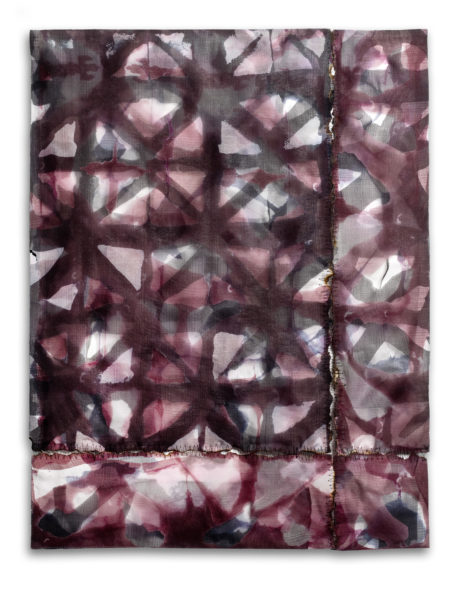
New Work: Back to ‘Mending’
Yet another new work inspired by Hazel Hall’s poem, “Mending.” Full text of the poem is here. Written about 100 years ago (Hall died in 1924), it is the gift that keeps on giving! Hall describes a mundane household chore as a subversive act, ‘a little travesty on life.’ It just seems to fit our zeitgeist, doesn’t it?
This piece combines several of the techniques I have used in the last year: layered sheers, cutting, burning, and visible mending. It feels radical to me, but still beautiful. Similar to Haiku III, but dimensional instead of fused flat. Best of all, I have ideas for several more pieces in this style.
Stay tuned.
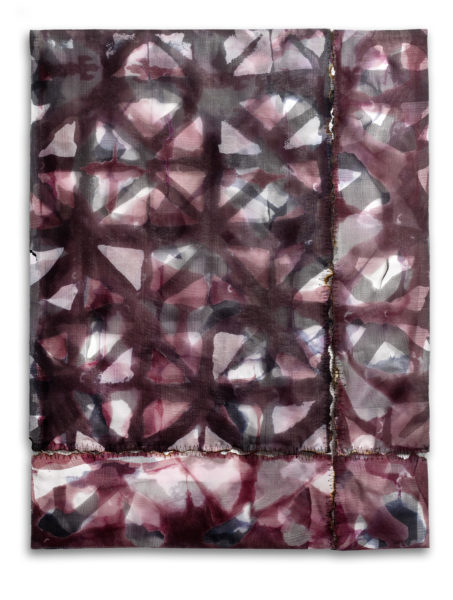

Fabric, dyes, fusible web.
Fusing, dyeing, burning, machine stitch, cut work.
photo credit: Jack Kulawik

When officers of the law become judge, jury, and executioners, killing unarmed black citizens, we all have a problem. The police act on our behalf. This slogan from the Black Lives Matter movement challenges our complicity in the face of these injustices. It demands our attention. We must find a way to hold our police officers close, and still hold them accountable. This piece is included in the Studio Art Quilt Associates Loaded Conversations exhibition.
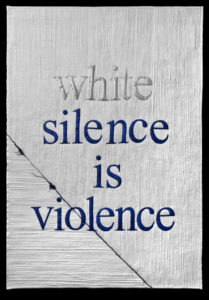
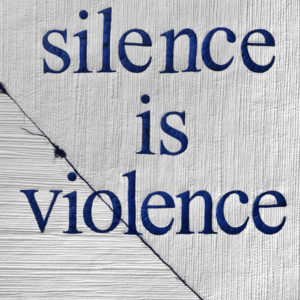
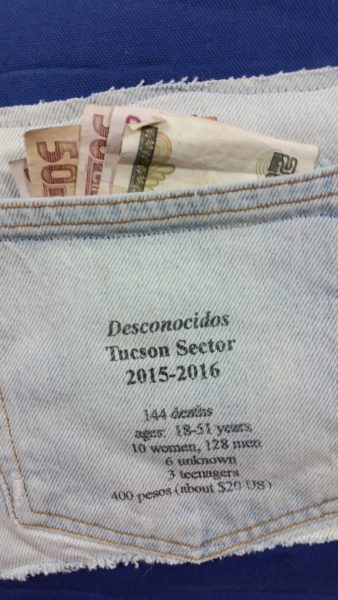

This piece was commissioned by The Migrant Quilt Project to honor and call attention to those who died crossing the border in the 2015-2016 fiscal year. It is made in part with clothing discarded at the border by migrants. The Project commissions a quilt each year, and the quilt must have the names of those whose have died while crossing, or, in the case of unidentified bodies, the word desconocido (unknown or stranger in Spanish). It was an honor to make this piece with Julia Moore, a high school intern who worked with me this winter. TMQP has received a grant for travelling exhibitions of these quilts beyond Tucson. Watch my blog for the next venue.
At the corner of East 15th Street and Kino Blvd. in Tucson is a monumental equestrian statue of Fr. Eusebio Francisco Kino. He was the first European to come to the area. He is, in a sense, our first border crosser. The statue (by Julian Martinez) looms large above the intersection and for years, I confess, I have wanted to quilt bomb it with an immigration theme. I am not sure how that is possible without access to a cherry picker. Not so subtle! I made a transparent silhouette of the statue to incorporate into this piece. The quilt also features a Virgin of Guadalupe, a marijuana-themed bandanna, and 400 pesos (which I found secreted into the hems of two pairs of jeans). Money and drug cartels frequently prompt these attempted crossings.
The numbers for Desconocidos The Migrant Quilt Project this year? One hundred forty-four deaths. The identified are aged 18-51 years. Ten women, 128 men, 6 unknown. Three are teenagers.
Materials: fusing, clothing, synthetic sheers, thread, canvas, felt.
Techniques: Burning, machine quilting, fusing, embellishing, image transfer.





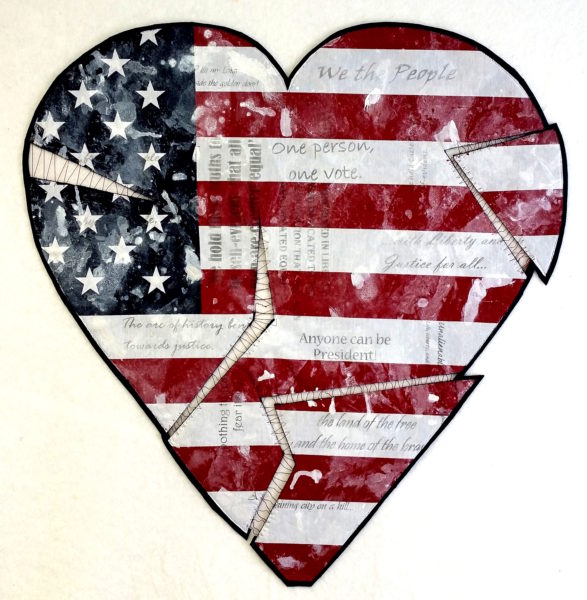
Hazel Hall’s poem ‘Mending’ reveals mending as a subversive act, an act of defiance, ‘a little travesty.’ Those who disagree with the current administration must put aside our shock and grief at the loss for what we thought America was, and fight for American ideals, to mend what is broken in this country.
Those who work in textiles have a long history of political activism. Like Betsy Ross. Or Madame Defarge. Watch Threads of Resistance for many political art quilts, or little travesties.


The full text of the poem is here:
Here are old things:
Fraying edges,
Ravelling threads;
And here are scraps of new goods,
Needles and thread,
An expectant thimble,
A pair of silver-toothed scissors.
Thimble on a finger,
New thread through an eye;
Needle, do not linger,
Hurry as you ply.
If you ever would be through
Hurry, scurry, fly!
Here are patches,
Felled edges,
Darned threads,
Strengthening old utility,
Pending the coming of the new.
Yes, I have been mending …
But also,
I have been enacting
A little travesty on life.
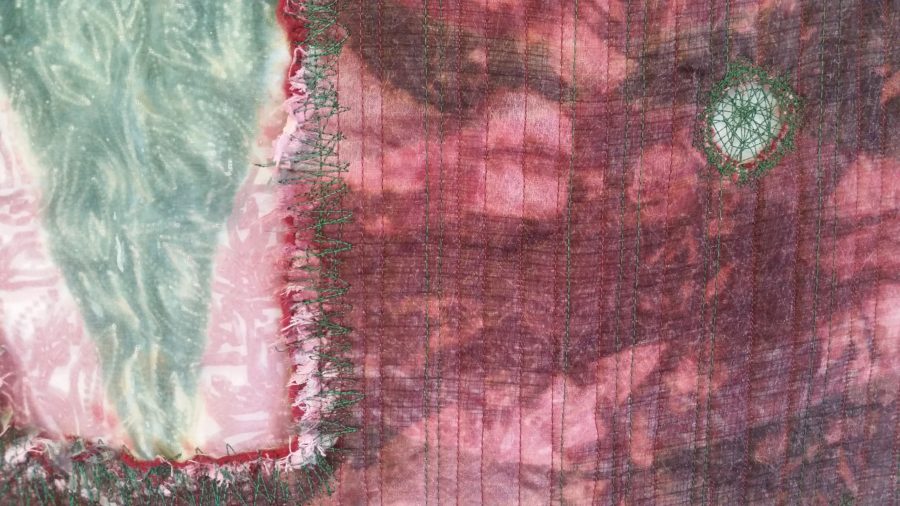
My latest art quilt, Yes, I Have Been Mending was inspired by 2 ideas. One is Hazel Hall’s poem, Mending. I recently discovered her poetry through Poets.org’s Poem-a-Day program. It is great to have a poem delivered to my in-box every day. I don’t always read it, but it is there! Hall used stitch imagery in several of her poems, so I was delighted to read her work.
The second idea that inspired me was the visible mending trend. It’s a lot like it sounds, but check out the link or Pinterest for some examples. ‘Yes, I Have Been Mending’ uses several gorgeous layers of hand-dyed silks, which I layered with eco-felt. And then I took an Exacto knife and sand paper to it to create holes. A bit of a travesty, but that is part of the poem! I then patched the red quilt with green thread and some more hand-dyed silks.
My favorite line in Mending is the last. The complete text of the poem is below:
Here are old things:
Fraying edges,
Ravelling threads;
And here are scraps of new goods,
Needles and thread,
An expectant thimble,
A pair of silver-toothed scissors.
Thimble on a finger,
New thread through an eye;
Needle, do not linger,
Hurry as you ply.
If you ever would be through
Hurry, scurry, fly!
Here are patches,
Felled edges,
Darned threads,
Strengthening old utility,
Pending the coming of the new.
Yes, I have been mending …
But also,
I have been enacting
A little travesty on life.
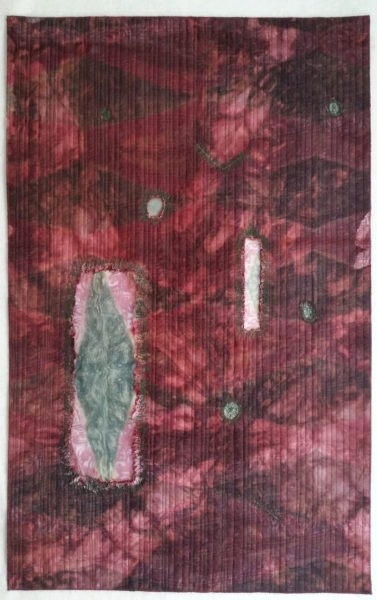

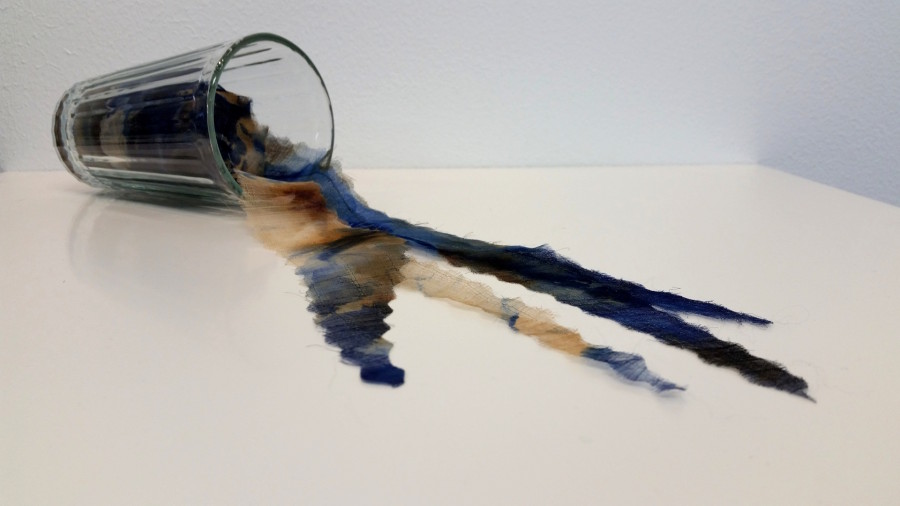
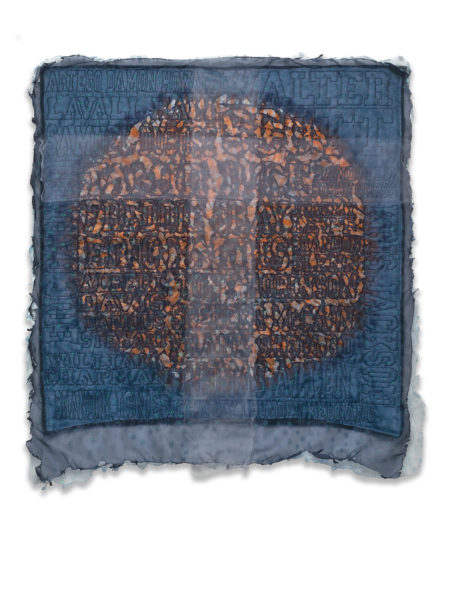

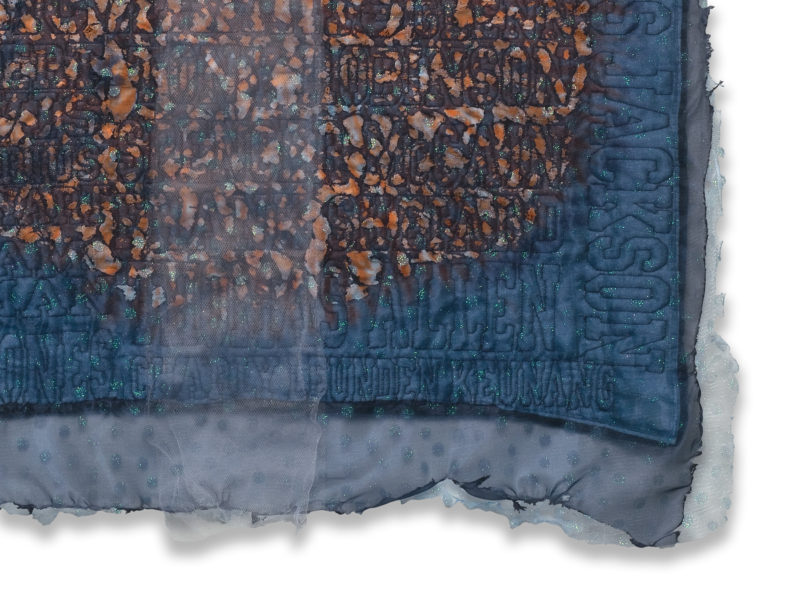
Abuela Reads the Headlines , 2015
Abuela is Spanish for grandmother. I imagine her in her barrio (neighborhood) garden in my hometown, Tucson, surrounded by an ocotillo (a living, cactus-type) fence. She has her handwork and the blessed Virgin of Guadalupe nearby, with a grandchild at her knee. Abuela scans the headlines about America’s current immigration policy, and weeps.
Materials: vintage handworked textiles (makers unknown), felted wool, embellishing (480 jewelry spikes), cotton and cotton-silk fabric, dyeing, discharging, silk sari ‘yarn,’ window screen, acrylic felt, embellishments (milagros and crystal rosary), synthetic organza.
Techniques: dyeing, heat and chemical burning, wet felting, hand stitching, couching, machine stitch, discharging, devore, dyeing, cutting.
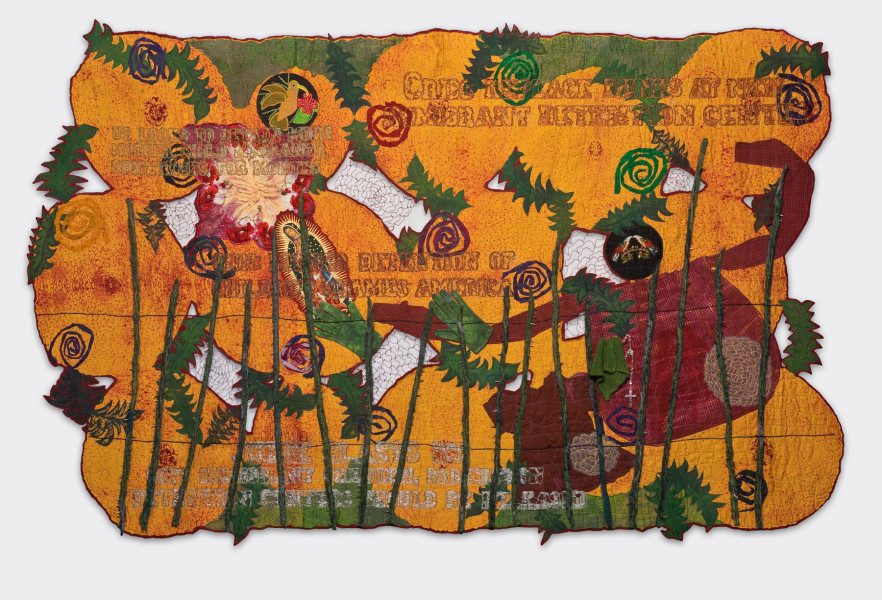
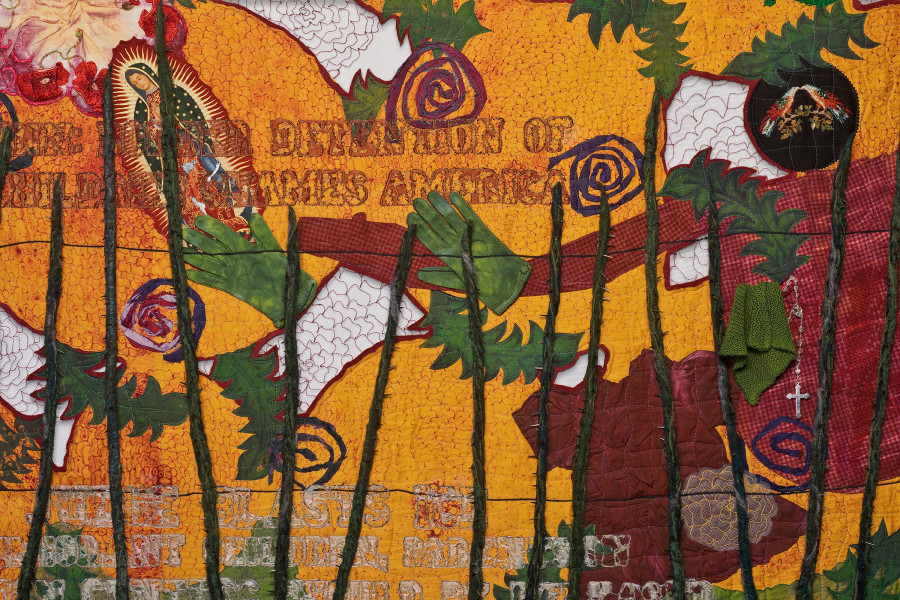
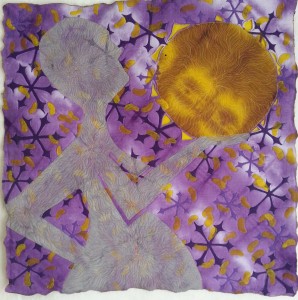
Quilt for Change recently asked me to submit a piece for their Light, Hope, and Opportunity Challenge. The project raises awareness about the Solar Sisters program, where African women entrepreneurs are given loans to start their own businesses. They buy inexpensive rechargeable solar lights to sell in their communities. This means fewer costly and dangerous kerosene lanterns in African villages. What a great cause! The exhibition will start in Geneva next month, and hopefully travel to the US.
I have been thinking about burning the edges of a piece for a while, and this seemed like an excellent opportunity.
Here is my artist statement for the piece:
Lucina Lighting the Way
Lucina was the Roman goddess of light and childbirth: She who brings children into the light. Here, the pregnant goddess holds a golden orb. The lively color scheme and bright shapes evoke a hopeful spring. This quilt is a tribute to modern-day Lucinas, our Solar Sisters, who are bringing safe, affordable, solar-powered light to their friends and neighbors. The singed edges are a reminder of the dangers of kerosene lanterns, which maim and kill users across Africa each year. Hand-dyed, and printed linen, painted silk, layered and machine stitched. Techniques include cutwork with a burned-edge finish.
detail:
